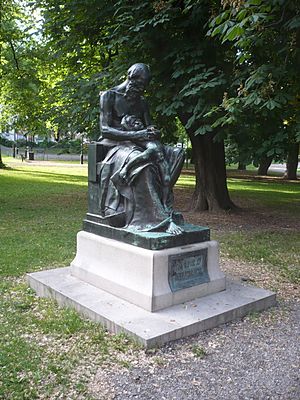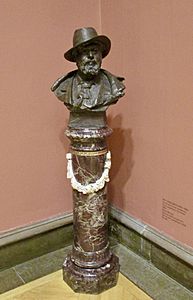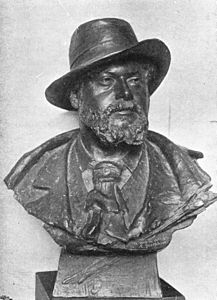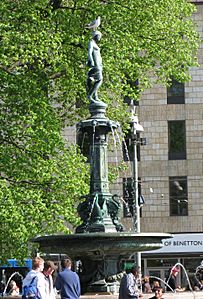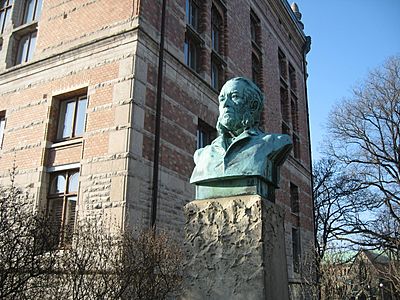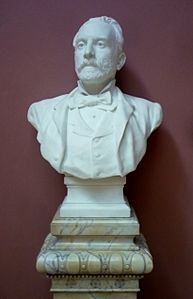Per Hasselberg facts for kids
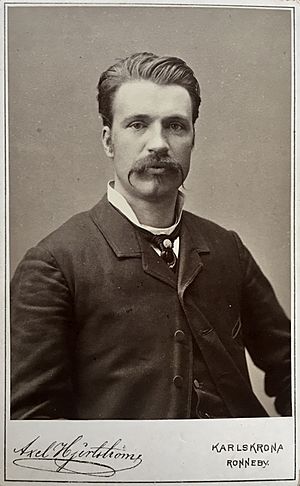
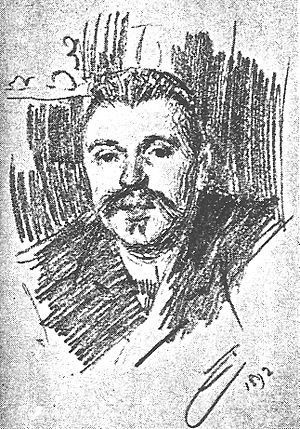
Per Hasselberg (born January 1, 1850 – died July 25, 1894) was a famous Swedish sculptor. Until 1870, his name was Karl Petter Åkesson.
Contents
About Per Hasselberg
Per Hasselberg was born on January 1, 1850. His birthplace was a small village called Hasselstad, near Ronneby in southern Sweden.
He grew up in a poor family. He was the sixth of many children. His father, Åke Andersson, was a small farmer. He also worked as a builder for bridges and made furniture.
Per finished school when he was twelve. He then started training to be a carpenter in Karlshamn. There, he also learned to carve beautiful decorations. In 1869, he moved to Stockholm. He worked as a decorative carver and took evening classes at a craft school.
In 1876, Per received a special scholarship. This money helped him travel to Paris, France. The next year, he was accepted into a famous art school there, the École nationale supérieure des Beaux-Arts. For three years, he studied with a well-known sculptor named François Jouffroy. Per then worked as a sculptor in Paris until 1890. That year, he moved back to Stockholm and opened his own art studio.
In 1885, Per became very ill. He was treated at the Sahlgrenska University Hospital in Gothenburg. Doctors told him he might only have a few years left to live. He got better for a while, but his health got worse again in 1894. He passed away on July 25 in Stockholm.
When he died, Per Hasselberg had no debts. He also had many orders for new sculptures. These orders were worth a lot of money. He wanted his friend, sculptor Christian Eriksson, to finish his last big projects. Christian Eriksson did complete them.
Per Hasselberg's Famous Sculptures
Snöklockan (The Snowdrop, 1881)
Snöklockan means "The Snowdrop" in Swedish. Its first name in French was La Perce-Neige, which means "snow breaker." Per first made this sculpture in plaster in Paris in 1881. It was shown at a big art show called the Salon. The model for the statue was a 16-year-old girl from Italy. At her feet, there is a small snowdrop flower. The statue was meant to show new life pushing through the snow in springtime.
The name Snöklocka is a poetic way to say "snowdrop" in Swedish. It adds a musical feeling to the statue. This is why the girl's right hand is near her right ear.
Snöklockan was a big success at the 1881 Salon. It even received a special mention, which no other Swedish artwork got that year. This made Per Hasselberg famous in Sweden. The Nationalmuseum in Stockholm quickly ordered a marble copy. This copy was finished in 1883 and won a gold medal in Paris. The Gothenburg Museum of Art also got a marble copy in 1885. The Ny Carlsberg Glyptotek in Copenhagen, Denmark, has one too. You can find bronze copies of Snöklockan in public places like Maria Square in Stockholm, and in Falun, Ronneby, and near Sunne.
Many smaller copies of the sculpture were also made. From 1887 to 1926, a company called Gustavsberg porcelain produced about 1,700 pieces. These were made from a material called parian ware, which looks like marble.
Farfadern (The Grandfather, 1886)
Farfadern means "The Grandfather" in Swedish. The French name was L'Aiëul. Per first made this sculpture in plaster in Paris in 1886. It was shown at the Palais de l'Industrie that year. The main idea behind this artwork was to show how life goes in a cycle, from young to old.
This idea came to Per when he was recovering from his illness in 1885. He knew he might not have much time left. So, he wanted this sculpture to be his artistic message to the world. The idea became clearer after he saw an old man sitting with a sleeping boy on his lap in Paris. When he finished it, his artist friends loved it. However, the exhibition in Paris was not a big success for this piece.
The original plaster copies made by Per are now lost. But a bronze copy was placed near the National Library of Sweden in Stockholm in 1896. A marble copy, also from 1896, is now at the Gothenburg Museum of Art.
Grodan (The Frog, 1889)
Grodan means "The Frog." Per made this sculpture in plaster for the Exposition Universelle (1889) in Paris. It was shown there. The sculpture shows a girl with a frog between her knees. Per said that the idea for this artwork came to him naturally. One day, a model in his studio sat on the floor in this position to rest during a break.
Some people thought this statue showed the different sides of youth.
Many bronze copies of Grodan are in public parks in Sweden. Marble copies are in museums. A new bronze copy was placed in Ulricehamn in 2009. It replaced an older copy that had been stolen. Smaller copies were also made from parian ware by Gustavsberg porcelain between 1906 and 1926.
Näckrosen (The Water Lily, 1892)
Näckrosen means "The Water Lily." This sculpture was first shown in plaster in Copenhagen, Denmark, in 1892. Later that year, it was shown in Gothenburg, Sweden. In 1893, it was part of the World's Columbian Exposition in Chicago.
The statue shows a young woman lying on her back. She is floating on a large water lily leaf. Around her are more water lilies and heads of old men. These old men represent mermen, which are water spirits. The first part of the flower's name, näck, means "water spirit" in Scandinavia. So, Näckrosen can also mean "Water Spirit Rose." Per Hasselberg made this connection clear by adding the old men's heads in the water. On the back of the sculpture, there is a tree stump with a chain and a large padlock. This suggests that the water lily leaf is chained down.
Gallery


